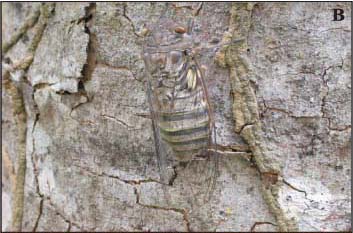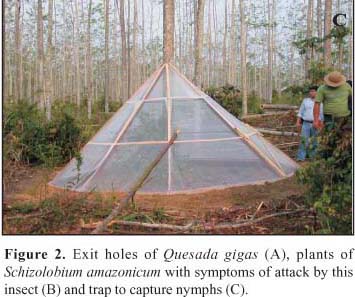Abstracts
An infestation of Quesada gigas Olivier (Hemiptera: Cicadidae) on "paricá" Schizolobium amazonicum (Huber) Ducken (Fabales: Fabaceae) was reported in the Municipalities of Itinga, Maranhão State and Paragominas, Pará State. Nymphs of this insect on roots and adults and exuvias on trunks of the plant were observed. Exit holes of nymphs in the soil were also observed. The occurrence of Q. gigas on S. amazonicum shows the damage potential of this species and the necessity of developing integrated management programs for species of this group, specially in reforested areas with "paricá".
Cicadidae; cicada; reforestation; soil pest; paricá
Há relatos sobre a infestação de Quesada gigas Olivier (Hemiptera: Cicadidae) em paricá Schizolobium amazonicum (Huber) Ducken (Fabales: Fabaceae) nos municípios de Itinga, Estado do Maranhão e Paragominas, Estado do Pará. Observaram-se ninfas nas raízes e adultos e exúvias nos troncos da planta. Orifícios no solo, de saída de ninfas móveis dessa cigarra também foram verificados. A ocorrência de Q. gigas em S. amazonicum mostra o potencial de danos da espécie e a necessidade de se desenvolver programas de manejo integrado de espécies desse grupo, principalmente Q. gigas, em áreas reflorestadas com paricá.
Cicadidae; cigarras; reflorestamento; pragas de solo; paricá
NOTAS CIENTÍFICAS
Occurrence of Quesada gigas on Schizolobium amazonicum trees in Maranhão and Pará States, Brazil
Ocorrência de Quesada gigas em Schizolobium amazonicum em municípios do Maranhão e do Pará
José Cola ZanuncioI; Fabrício Fagundes PereiraI; Teresinha Vinha ZanuncioI; Nilza Maria MartinelliII; Tobias Baruc Moreira PinonI; Edylene Marota GuimarãesI
IUniversidade Federal de Viçosa, Dep. de Biologia Animal/BIoagro, Avenida P.H. Rolfs, s/nº, CEP 36571-000 Viçosa, MG. E-mail: zanuncio@ufv.br, ffpereira@insecta.ufv.br
IIUniversidade Estadual Paulista, Dep. de Fitossanidade, Via de Acesso Paulo Donato Castellane, s/nº, CEP 14884-900 Jaboticabal, SP. E-mail: nilza@fcav.unesp.br
ABSTRACT
An infestation of Quesada gigas Olivier (Hemiptera: Cicadidae) on "paricá" Schizolobium amazonicum (Huber) Ducken (Fabales: Fabaceae) was reported in the Municipalities of Itinga, Maranhão State and Paragominas, Pará State. Nymphs of this insect on roots and adults and exuvias on trunks of the plant were observed. Exit holes of nymphs in the soil were also observed. The occurrence of Q. gigas on S. amazonicum shows the damage potential of this species and the necessity of developing integrated management programs for species of this group, specially in reforested areas with "paricá".
Index terms: Cicadidae, cicada, reforestation, soil pest, paricá.
RESUMO
Há relatos sobre a infestação de Quesada gigas Olivier (Hemiptera: Cicadidae) em paricá Schizolobium amazonicum (Huber) Ducken (Fabales: Fabaceae) nos municípios de Itinga, Estado do Maranhão e Paragominas, Estado do Pará. Observaram-se ninfas nas raízes e adultos e exúvias nos troncos da planta. Orifícios no solo, de saída de ninfas móveis dessa cigarra também foram verificados. A ocorrência de Q. gigas em S. amazonicum mostra o potencial de danos da espécie e a necessidade de se desenvolver programas de manejo integrado de espécies desse grupo, principalmente Q. gigas, em áreas reflorestadas com paricá.
Termos para indexação: Cicadidae, cigarras, reflorestamento, pragas de solo, paricá.
Cicadas are hemimetabolic insects that usually feed on sap of native plants. However, plantations in extensive areas with a predominant species can lead to biological unbalance which favors the adaptation of species of this group to such conditions (Martinelli & Zucchi, 1997a; Reis et al., 2002).
Researches on cicadas in Brazil have been restricted to species of this group associated to coffee plants (Coffea arabica L.) due to damage caused by these insects in plantations in the states of Minas Gerais, São Paulo and Paraná. This situation has led to studies on taxonomy, biology, geographical distribution and host preference aiming to minimize damage potential of these insects (Martinelli & Zucchi, 1997a). The elaboration of identification keys made possible to recognize species of cicada associated to coffee plants (Martinelli & Zucchi, 1997a) and monitoring programs have been developed to determine the geographical distribution of these species in Brazil (Martinelli, 1990). The cicada Quesada gigas Olivier (Hemiptera: Cicadidae) is the main pest of this group in the coffee culture, but this species have also been reported in other hosts such as Acacia farnesiana, Caesalpinia peltophoroides, Cassia spp., Morus alba, American persea, Piptadenia sp. and Theobroma cacao (Martinelli & Zucchi, 1997b).
Q.gigas presents the largest geographical distribution and it is the better studied species of the ten most important of this group in the American continent. Besides, it is the only species which has been registered in North America, the Antillas and in most Brazilian States where coffee is produced (Martinelli & Zucchi, 1987). Plants attacked by cicada nymphs present chlorosis of leaves in branch extremities, losses of leaves, nude branches, leaves only in the apexes, low production and death of plants (Reis et al., 2002).
An infestation of a cicada species was registered in November 2002 in a reforested area with Schizolobium amazonicum (Huber) Ducken (Fabales: Fabaceae) plants in Itinga, Maranhão State and Paragominas, Pará State with severe damage to trees in 15 hectares. Immobile nymphs and adults (Figure 1) of this insect were observed on trunks of trees as well as circular holes (Figure 2A) in the soil around trunks of S. amazonicum trees, which are exit holes of movable nymphs of cicadas. After leaving the soil, these nymphs turn to an immobile stage and after a final molting the adult emerges. Such holes demonstrated that these nymphs were attacking S. amazonicum roots (Figure 1C), leading to a fall of leaves and reduction on growth (Figure 2B). This damage is similar to that observed in coffee trees with emphasized symptoms during periods of water deficit and with insignificant blooming, low fruit production and tree death if this pest is not controlled (Reis et al., 2002).
Adults cicadas were manually collected in trunks of S. amazonicum and seemed to belong to a single species. Movable nymphs of this insect were collected with traps (Figure 2C) made of a two-meter-diameter cloth screen around S. amazonicum trees when they left the soil through exit holes. Adults of this cicada were killed, fixed in alcohol 70% and sent to Universidade Estadual Paulista for identification. Insects were identified as Q. gigas and they represent the first report of this species on S. amazonicum in Itinga, Maranhão State and Paragominas, Pará State.
The substitution of native hosts by monoculture in extensive areas and cultivation during long periods can be one of the reasons which explains biological unbalance presented by some insects such as cicadas especially with species of the family Cicadidae. These insects are adapting to the new conditions where they can obtain food from cultivated plants (Martinelli & Zucchi, 1997b).
The fact that studies on cicadas have been usually restricted to species associated to coffee trees (Coffea spp.) in Brazil shows the necessity of developing researches to identify the occurrence and to minimize damages by these insects to other cultures. The potential of damage of Q. gigas in S. amazonicum needs to be considered because the area reforested with this plant is over 20,000 hectars in the States of Maranhão and Pará and damages to trees attacked by this insect were very severe. It also shows the necessity of studies on the efficiency of insecticides to be used in forest areas to control this pest in emergence situations, giving priority to low toxicity products in order to reduce environmental impacts of these operations.
Acknowledgements
To Conselho Nacional de Desenvolvimento Científico e Tecnológico (CNPq), to Coordenação de Aperfeiçoamento de Pessoal de Nível Superior (Capes) and to Fundação de Amparo à Pesquisa do Estado de Minas Gerais (Fapemig), for grants and scholarship.
Received on February 18, 2004 and accepted on May 18, 2004
- MARTINELLI, N.M. Café. As cigarras que causam danos à cultura. Correio Agrícola, v.2, p.11-13, 1990.
- MARTINELLI, N.M.; ZUCCHI, R.A. Cigarras associadas ao cafeeiro: I. Gênero Quesada Distant, 1905 (Homoptera, Cicadidae, Cicadinae). Anais da Sociedade Entomológica do Brasil, v.16, p.51-60, 1987.
- MARTINELLI, N.M.; ZUCCHI, R.A. Cigarras (Hemiptera, Cicadidae, Tibicinidae): distribuição, hospedeiros e chave para as espécies. Anais da Sociedade Entomológica do Brasil, v.26, p.133-141, 1997a.
- MARTINELLI, N.M.; ZUCCHI, R.A. Primeiros registros de plantas hospedeiras de Fidicina mannifera, Quesada gigas e Dorisiana drewseni (Hemiptera: Cicadidae). Revista de Agricultura, v.72, p.271-281, 1997b.
- REIS, P.R.; SOUZA, J.C.; VENZON, M. Manejo ecológico das principais pragas do cafeeiro. Informe Agropecuário, v.23, p.83-99, 2002.
Publication Dates
-
Publication in this collection
03 Nov 2004 -
Date of issue
Sept 2004
History
-
Accepted
18 May 2004 -
Received
18 Feb 2004







